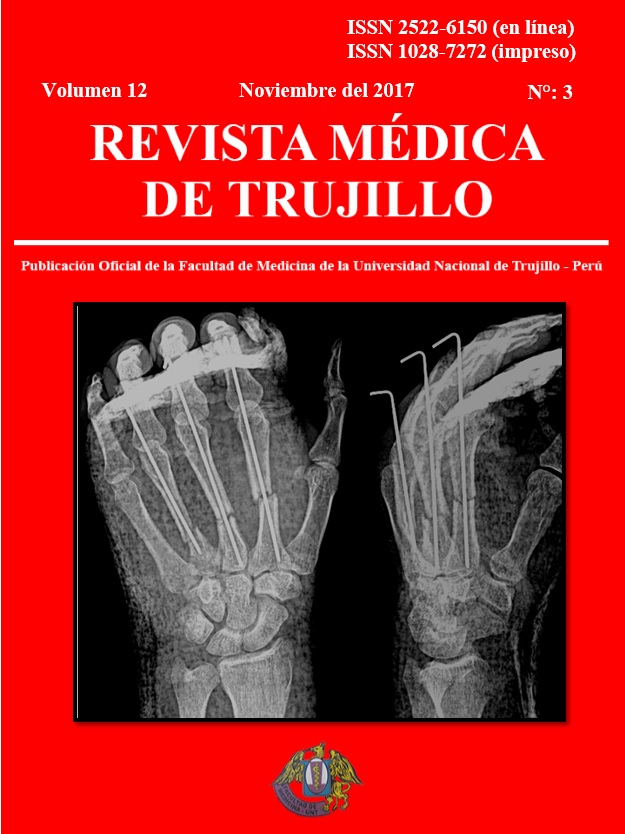Cesárea electiva como factor de riesgo de asma infantil
Abstract
Introducción: El nacimiento por cesárea electiva ha ido en aumento según los últimos años, por ello la Organización Mundial de la Salud emitió un comunicado exhortando a solo realizar cesáreas en casos de emergencia; la asociación entre el aumento de cesáreas y el desarrollo de asma en niños ha sido motivo de diferentes estudios, planteando la predisposición a la enfermedad debido al retardo de la madurez inmunológica obtenida por el modo de nacimiento. Objetivo: demostrar que el nacimiento por cesárea electiva es factor de riesgo de asma en niños de 2 a 5 años. Materiales y métodos: estudio de casos y controles que incluyó las historias clínicas de 432 niños (216 casos y controles) atendidos en el Hospital Regional Docente de Trujillo (Perú) entre los años 2004-2014. Resultados: nacer por cesárea electiva mostró asociación con el riesgo de enfermar de asma (Odds ratio [OR]:1,63; Intervalo de confianza [IC] 95%:1,11-2,41), p= 0,014. Conclusión: El nacer por cesárea electiva es factor de riesgo de asma en niños de 2 a 5 años.
Palabras clave: Cesárea electiva, asma, niños, preescolar.References
Lindmeier C. Solo se deben practicar las cesáreas que sean necesarias por motivos médicos. HTML [En línea] 2015 [Fecha de acceso 13 de Abril de 2015]. OMS. Disponible en: http://www.who.int/mediacentre/news/releases/2015/caesarean-sections/es/.
Priori E, Reategui E, Rodríguez M, Rojas V, Saenz L. Cesárea como factor de riesgo para desarrollar asma bronquial en niños entre 3 y 5 años. Instituto Nacional de Salud del Niño. 2010: 49. Spanish.
Xu B, Pekkanen J, Järvelin M. Obstetric complications and asthma in childhood. J Asthma. 2000; 37(7): 589-94.
Håkansson S, Källén K. Caesarean section increases the risk of hospital care in childhood for asthma and gastroenteritis. Clin Exp Allergy. 2003; 33(6): 757-64.
Bråbäck L, Ekéus C, Lowe A, Hjern A. Confounding with familial determinants affects the association between mode of delivery and childhood asthma medication – a national cohort study. Allergy Asthma Clin Immunol. 2013; 9(1):14.
Nathan A, De Bruyne J, Khalid F, Arumugam F. Caesarean section and asthma in Malaysian children: a case-control study. Asian Pac J Allergy Immunol. 2012; 30(3): 204-8.
Park Y, Kim K, Choi B, Jee H, Sohn M, Kim K. Relationship between mode of delivery in childbirth and prevalence of allergic diseases in Korean children. Allergy Asthma Immunol Res. 2010; 2(1): 28-33.
Cho C, Norman M. Cesarean section and development of the immune system in the offspring. Am J Obstet Gynecol. 2013; 208(4): 249-54.
Kolokotroni O, Middleton N, Gavatha M, Lamnisos D, Priftis K, Yiallouros P. Asthma and atopy in children born by caesarean section: effect modification by family history of allergies – a population based cross-sectional study. BMC Pediatrics. 2012; 12: 179-87.
Almqvist C, Oberg A. The association between caesarean section and asthma or allergic disease continues to challenge. Acta Paediatr. 2014; 103(4): 349-51
Castro-Rodríguez J. Factores de riesgo para asma infantil. Neumología Pediátrica. 2000. p: 55-8.
Tollånes M, Moster D, Daltveit A, Irgens L. Cesarean Section and Risk of Severe Childhood Asthma: A Population-Based Cohort Study. J Pediatr. 2008; 153(1): 112-6.
Council for International Organizations of Medical Sciences. International ethical guidelines for epidemiological studies. HTML [En Línea]. 2008 [Fecha de acceso 15 de Abril de 2015] Disponible en: http: www.ufrgs.br/bioetica/cioms2008.pdf
Thavagnanam S, Fleming J, Bromley A, Cardwell C. A meta-analysis of the association between Caesarean section and childhood asthma. Clinical and Experimental Allergy. 2007; 38, 629–33
Huang L, Chen Q, Zhao Y, Wang W, Fang F, Bao Y. Is elective cesarean section associated with a higher risk of asthma? A meta-analysis. J Asthma. 2015; 52(1): 16-25.
Jaakkloa , Ahmed P, Leromnimon A, Goepfert P, Laiaou, Quansah R, et al. Preterm delivery and asthma: a systematic review and meta-analysis. J Allergy Clin Immunol. 2006; 118(4): 823-30
Abrahamsson T, Sandberg A, Forsberg A, Bjorksten B, Jenmalm C. A Th1/Th2-associated chemokine imbalance during infancy in children developing eczema, wheeze and sensitization. Clin Exp Allergy. 2011; 41(12): 1729-39.
Dominguez-Bello M, Costello E, Contreras M. Delivery mode shapes the acquisition and structure of the initial microbiota across multiple body habitats in newborns. Proc Natl Acad Sci U S A. 2010; 107(26): 11971-5.
Bjorksten B, Sepp E, Julge K, Voor T, Mikelsaar M. Allergy development and the intestinal microflora during the first year of life. J Allergy Clin Immunol. 2001; 108(4): 516-20.
Salminen S, Gibson G, McCartney A, Isolauri E. Influence of mode of delivery on gut microbiota composition in seven year old children. Gut. 2004; 53(9): 1388-9.
Geuking M, Köller Y, Rupps S, McCoy K. The interplay between the gut microbiota and the immune system. Gut Microbes. 2014; 5(3): 411–8.
Levine E, Ghai V, Barton J, Strom C. Mode of delivery and risk of respiratory diseases in newborns. Obstet Gynecol 2001; 97: 439-42.
Karvonen A, Hyvärinen A, Korppi M, Haverinen U, Renz H, Pfefferle P, Remes S, Genuneit J, et al. Moisture damage and asthma: a birth cohort study. Pediatrics. 2015; 135(3): e598-606.
Brauer M, Hoek G, Van-Vliet P, Meliefste K, Fischer P, Wijga A, et al. Air pollution from traffic and the development of respiratory infections and asthmatic and allergic symptoms in children. Am J Respir Crit Care Med. 2002; 166(8): 1092–8.
Escamilla M, Barraza A, Hernandez L, Moreno H, Ramirez M, Sienra J, et al. Traffic-related air pollution and respiratory symptoms among asthmatic children, resident in Mexico City: the EVA cohort study. Respir Res. 2008; 9(1): 74-85.
Forno E, Gogna M, Cepeda A, Yañez A, Solé D, Cooper P, et al. Asthma in Latin America. Thorax. 2015; 70(9): 898-905.
Jhun Y, Weaver A, Katusic S, Yunginger J. Mode of delivery at birth and development of asthma: a population-based cohort study. J Allergy Clin Immunol. 2005; 116(3): 510-6.
Maitra A, Sherriff A, Strachan D, Henderson J. Mode of delivery is not associated with asthma or atopy in childhood. Clin Exp Allergy. 2004; 34(9): 1349-55.










